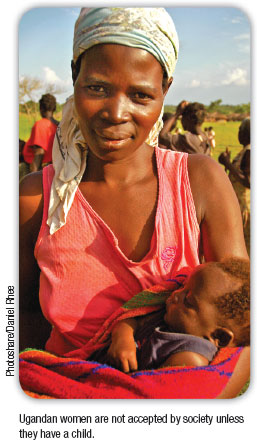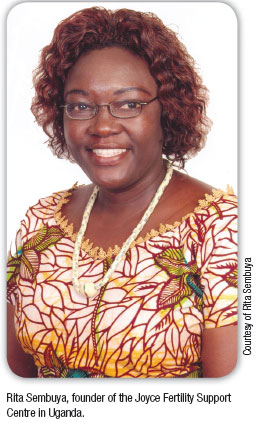NEWS
Mother or nothing: the agony of infertility
Many infertile women in developing countries consider that, without children, their lives are without hope. Weiyuan Cui reports on the burden many of these women carry and the lack of affordable care.
Ann [not her real name] lives in Kampala, Uganda, with her husband and one child from her husband's previous relationship. When she was married in 1996, Ann happily accepted his then four-year-old boy in the hope that one day she would have a biological child of her own. Unfortunately, in the early years of her marriage, she suffered several miscarriages including one that caused "extreme pain" and bleeding and rendered her unconscious.
"When I woke up, I found myself in the hospital. The doctor told me that I had an ectopic pregnancy. They had to take away the baby that was dying inside me," she says. Later she was told that she would no longer be able to conceive.
"Ectopic pregnancy can lead to infertility but more common causes include tubal occlusion from reproductive tract infections, which are often sexually transmitted, postpartum complications or unsafe abortion practices," says Dr Sheryl Vanderpoel from the Reproductive Health and Research Department at the World Health Organization (WHO). In countries such as India that have high rates of tuberculosis, genital tuberculosis is also a major, often undetected, cause of infertility.

Infertility affects up to 15% of reproductive-aged couples worldwide. WHO demographic studies from 2004 have shown that in sub-Saharan Africa, more than 30% of women aged 25-49 suffer from secondary infertility, the failure to conceive after an initial first pregnancy.
Although male infertility has been found to be the cause of a couple's failure to conceive in about 50% of cases, the social burden "falls disproportionately on women," according to Dr Mahmoud Fathalla, previous director of the Special Programme of Research, Development and Research Training in Human Reproduction based at WHO. "When a couple is unable to reproduce, the man may divorce his wife or take another wife if they live in a culture that permits polygamy," he says.
In many cultures, childless women suffer discrimination, stigma and ostracism. For example, Ann was banned from attending her father-in-law's funeral. "The relatives, when getting together, talk a lot about their children or being pregnant and having children. Those are the moments when I feel extremely isolated. So often, people do not regard you as a human. There is no respect," she laments. "Women like me often have to bear the extra-marital relationships that our husbands tend to have. I have overheard other women talking about us as being cursed."
According to Vanderpoel, "the stigmatization can be extreme in some countries, where infertile people are viewed as a burden on the socioeconomic well-being of a community. Stigma extends to the wider family, including siblings, parents and in-laws, who are deeply disappointed for the loss of continuity of their family and contribution to their community. This amplifies the guilt and shame felt by the infertile individual," she says.
Rita Sembuya, founder of the Joyce Fertility Support Centre in Uganda, says that this frustration and agony is shared by all women who come to her centre. "Our culture demands that, for a woman to be socially acceptable, she should have at least one biological child," says Sembuya. "Almost all cultures across Africa put emphasis on women having children ... marriage without children is considered as a failure of the two individuals."
Uganda is one of the countries in the "African infertility belt" that stretches across central Africa from the United Republic of Tanzania in the east to Gabon in the west. In this region a phenomenon described as "barrenness amid plenty" refers to the fact that infertility is often most prevalent where fertility rates are also high.
"In a world that needs vigorous control of population growth, concerns about infertility may seem odd, but the adoption of a small family norm makes the issue of involuntary infertility more pressing," says Fathalla. "If couples are urged to postpone or widely space pregnancies, it is imperative that they should be helped to achieve pregnancy when they so decide, in the more limited time they will have available."
Despite their importance, infertility prevention and care often remain neglected public health issues, or at least they rank low on the priority list, especially for low-income countries that are already under population pressure. Low fertility is becoming more common worldwide, particularly in ageing populations and many urban settings where women are having their first babies at older ages.
Health policy-makers are increasingly being urged to begin to integrate infertility prevention, care and treatment into the work being done to strengthen maternal, newborn and reproductive health-care systems.
For many infertile women, particularly those with problems such as blocked or severely scarred fallopian tubes where surgical tubal repair is either not successful or not advisable, in vitro fertilization (IVF) can help. This technology enables eggs to be fertilized directly by sperm outside the woman's body, without the egg or sperm having to pass through a blocked tube. The fertilized embryo is then transferred back into the woman's uterus.
Unfortunately for most women in developing countries, infertility services are not widely available and IVF is unaffordable. While optimal utilization of IVF is estimated to be around 1500 cycles per one million population per year, provision of the service falls significantly short in developing countries, according to Dr Gamal Serour, president of the International Federation of Gynaecology and Obstetrics (FIGO) and director of the International Islamic Center for Population Studies and Research at Al Azhar University in Cairo, Egypt.
"As the cost of establishing advanced infertility centres is very high, only a limited number of centres were established in some low- and middle-income countries and most remain in the private sector," says Serour. In Uganda, an IVF service provider run by the Women's International Hospital relies on foreign doctors from Belgium, Kenya and Nigeria who fly in and out of the country. "This raises the cost and is not sustainable," says Sembuya.
The situation is further exacerbated by the lack of support women face, both emotional and financial. In sub-Saharan Africa "women are not encouraged by their male partners to seek modern technical treatments," says Serour. Combined with the widespread lack of insurance coverage, seeking fertility care often means a lonely path for women wishing to conceive.

"My husband is not supportive at all. He knows he could have more children from other relationships if he wants," says Ann, who sold her inheritance, a plot of land, to pay for one cycle of IVF. That cycle, costing Ann around US$ 4900, was not successful.
"At this rate, it will take me another nine years to save enough money for a second cycle, and by then I will be too old," Ann cried out of despair. "We cannot afford it. I am going to die without my own biological child."
For many infertile women in low-income countries, some hope may lie in the introduction of affordable infertility services. An inspiring example is Egypt, which has managed to reduce its population growth and expand infertility care at the same time. About 51 private and public infertility treatment centres have mushroomed in the past three decades. The busiest public centre, located in Al-Azhar University, Cairo, provides fertility care including subsidized IVF cycles for US$ 600 per cycle to serve hundreds of Egypt's infertile couples every year.
In India, pioneer programmes have been able to cut costs by one third by giving low doses of hormones to stimulate ovulation. "While this produces fewer eggs, it is more patient-friendly and we manage to obtain acceptable levels of healthy live birth rates," says Dr Suneeta Mittal, head of the Department of Obstetrics and Gynaecology at the All India Institute of Medical Sciences in New Delhi, India. Current costs of one IVF cycle are around 60 000 Indian rupees (US$ 1300), the equivalent of six months' salary for some couples. Her clinic is working to reduce this cost to 20 000 rupees (US$ 430) and to develop a programme that targets prevention of infection and education about fertility. "There's so much stigma attached to being infertile in India. It is so important to address this issue," she says.

"Services to assist infertile couples need to be integrated and holistic - starting from the community level to demystify the cause and prevent infertility when possible, and to provide referral for affordable care if infertility is unavoidable," Vanderpoel adds. "Infertility prevention also involves important lifestyle choices. The outcome of quality fertility care is a healthy birth. Maternal and newborn health does not begin during antenatal care, nor should it only be addressed at the time of birth. Rather, it starts with quality reproductive health care which includes pre-conception fertility care." 
